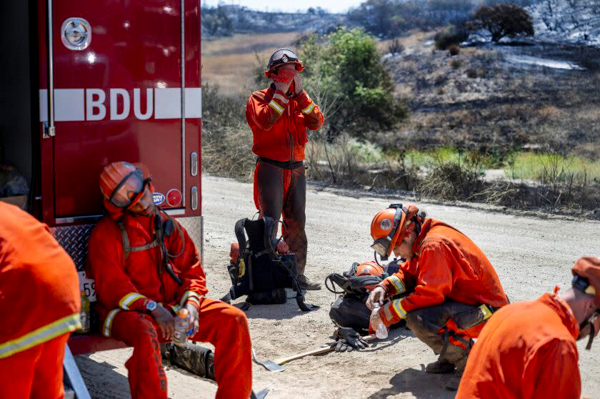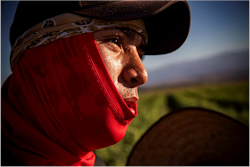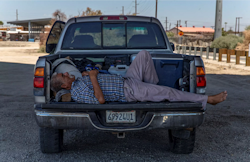SEJournal Online is the digital news magazine of the Society of Environmental Journalists. Learn more about SEJournal Online, including submission, subscription and advertising information.
 |
 |
| A fire crew takes a break from the 105° F heat while putting out hot spots in the Rabbit fire in Beaumont, Calif. Photo courtesy Gina Ferazzi/Los Angeles Times. |
EJ InSight: Capturing the Invisible — Photographing Extreme Heat Waves
By Silvia Rázgová, with additional reporting by Andrew Cullen
There has been no shortage of natural disasters this year. Some, like the earthquakes in Turkey, Morocco and Afghanistan, were geologic. Others — floods in Vermont, Libya and Greece; wildfires in Canada, Maui and the Mediterranean — can be linked to climate change.
Among all the damage and dramatic news coverage, the emergency that stood out in my thoughts was a quieter, more prolonged disaster-in-the-making, which captivated me both because it seemed to be spiraling in scope in the course of just a few months, and because of the challenges it presents to photographers trying to document it.
Extreme heat.
Throughout the past summer and across the globe, heat waves blazed up and then lingered. Europe experienced unusually high temperatures for unusually long periods. The Andes had a winter heatwave.
In the United States, waters off the coast of Florida sparked fears of coral bleaching. And cities in the South and West set records for consecutive days with extremely high temperatures: 44 days with highs over 100° F in El Paso; 31 straight days over 110° F and 55 days with highs over 110° F in total this year in Phoenix.
Photographers and other
visual journalists must figure out
how to demonstrate a force
that cannot easily be seen.
The New York Times recently published an excellent overview (may require subscription) of these global heat events told through a series of infographics. But with extreme heat events growing in severity, photographers and other visual journalists must figure out how to demonstrate a force that cannot easily be seen.
The insidious nature of extreme heat
Even before my time as a photo editor, I observed discrepancies in how different publications visually represented extreme heat. Some recognized the gravity of these weather events and covered them appropriately, while others still approached them as extensions of summer-themed content.
Other extreme weather events are usually illustrated to demonstrate their gravity — an image of said event in action and affecting landscapes, animals and people. Life interrupted.
A flood story usually features images of rushing water swallowing roads and houses, aerials of lost cities and farmland, cars trapped in the mud and people embracing their pets in an inflatable rescue vessel. A wildfire story rotates images of flames doused with magenta fire retardant, charred landscapes and people sifting through the rubble of what once was a home.
Extreme heat stories frequently
feature images of fun in the sun —
children frolicking in water,
people eating ice cream.
In contrast, extreme heat stories frequently feature images of fun in the sun — children frolicking in water, people eating ice cream or picnicking in city parks.
Capturing extreme heat can be challenging due to its invisible nature, but it’s crucial to focus on the overall impact of the event rather than the pleasures of escaping it. Photographers and photo editors ought to acknowledge the insidiousness of extreme heat and treat it with the same seriousness as storms and fires.
Beyond fire hydrants and swimming pools
While working as a photo editor, I saw this disconnect in coverage firsthand. I learned that I got better results from extreme heat assignments when I asked the photographer to consider heat's effect on people who don’t have the privilege of heading to a beach when it is hot.
Successful photo assignments often brought back images of workers who can’t escape the heat or needed to adapt to it: farm and construction workers, woodland firefighters and street vendors. Others were observant images of city scenes where people sheltered from the sun during the commutes and outreach workers who tended to at-risk, unhoused folks.
 |
| Under a blistering sun, Steven Rodriguez, 21, picks okra at his father’s farm in the Coachella Valley. Photo courtesy Irfan Khan/Los Angeles Times. |
Ash Ponders, a freelance Panamanian-tisoy photojournalist based in Phoenix, photographed the city's record-breaking heat throughout the summer for outlets like The New York Times and the Los Angeles Times, including a powerful story on an air-conditioning repairperson and his clients. They echoed the value of discussing their photographic approach with editors and the challenge of finding unexpected angles.
“Apart from encouraging me to look for stories beyond the standard fire hydrants and swimming pools, my editors more or less were happy to have enterprise images from wherever I could find them,” Ponders wrote over email. “For stories, we spoke at length about various visual and narrative approaches to be sure we were creating novel images, rather than hewing close to the typical.”
“I did my best to find narrative threads that avoided cliche and redundancy. But I know at points, I was reduced to tropes. In fact, at one point, an editor asked me to find one of the oft-photographed electronic billboards that advertise the temperature. That photo, filed within moments of its creation, rode the front page of their website for hours.”
Internalizing relentless heat
Maybe it’s the "novelty" of extreme heat or its deceitful nature that makes it challenging for even the most news-savvy photojournalists to connect to the topic.
Ponders admits there are difficulties. “Honestly, at first I didn’t understand that this was going to be the hottest month of my life. I’d covered heatwaves (may require subscription) in years past. And I read the forecasts, but it was impossible for me to internalize what relentless heat really meant. As the days dragged on, with nighttime temperatures in the high 90s, I struggled to marshal my photographic plans into a cohesive narrative” while photographing for a variety of clients with individual needs for imagery.
As professionals, we understand
a topic best through personal and
intimate experiences with the story.
Whatever the connection difficulty, the cure is the same as in any engaging narrative. As professionals, we understand a topic best through personal and intimate experiences with the story. When working with reporters and editors, I always ask to be involved as early as possible.
For photographers on the ground, basic reporting skills like source cultivation go a long way. “My editors approached me with specific assignments as well, but I’ve always found that being deeply sourced/networked in my town allows me to give greater nuance and context to assignments from national outlets,” Ponders said.
Managing the risks
As when covering other disasters, photographers need to mind their own safety during these heat events.
 |
| A farmworker sleeps in the shade of the Avenue 66 Bridge in Mecca, California. Photo courtesy Irfan Khan/Los Angeles Times. |
“I did my best to stay cool, but fundamentally, visually documenting the realities of the heat from before dawn to past dusk is not safe,” Ponders said. “I got the beginnings of heat illness several times — as did many other photographers that covered the heat alongside me.”
Sunblock, wide-brimmed hats and light, long-sleeved clothing is essential. A backpack with a frozen hydration reservoir that melts throughout the day can help during long assignments in the heat. So can a full cooler of electrolyte beverages in the car and, most importantly, frequent breaks in air-conditioned areas.
As extreme heat events become more common, it’s important that photojournalists find new and more compelling ways to cover them.
Photos of extreme heat shouldn’t stoop to trauma porn, and won’t always be the most dramatic disaster images. But they need to give decision-makers the sense that heat is a new reality with broad-ranging implications to public health and the economy. They should also serve our local audiences, showing where people can find resources and relief when needed. And photographers and their editors will need to understand how to manage the risks while they work.
Silvia Rázgová is a former photo editor at the Los Angeles Times. She joined the Times in 2022 after previously working for the newspaper and other publications as a freelance photographer. Born in Slovakia, she immigrated to the United States in 2000 and received a master’s degree in journalism from the University of Colorado at Boulder. Rázgová has worked as a photojournalist for the Rocky Mountain News in Colorado and The National, an English-language newspaper in Abu Dhabi, United Arab Emirates. Based in Los Angeles since 2016, she works as a freelance photo editor and photojournalist. Her personal work explores the themes of home, loss, belonging and the poignancy of life.
Andrew Cullen was recently appointed co-editor of EJ InSight. An independent photojournalist and a 2022-2023 Ted Scripps Fellow for Environmental Journalism at CU Boulder, his work examines the complicated relationships between the environment and individual and communal identities. He has photographed for The New York Times, NPR, CNN, Reuters and many others.
* From the weekly news magazine SEJournal Online, Vol. 8, No. 45. Content from each new issue of SEJournal Online is available to the public via the SEJournal Online main page. Subscribe to the e-newsletter here. And see past issues of the SEJournal archived here.












 Advertisement
Advertisement 



